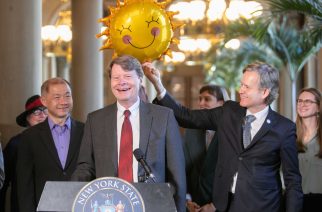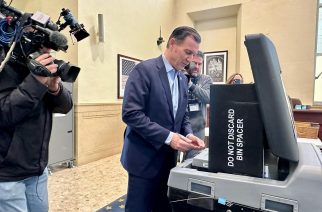
Majority of voters say Cuomo would be better than Molinaro on three issues: improving public education, fixing New York’s infrastructure and creating jobs
Plurality of upstate voters say Molinaro would be better on the challenges facing that region
Incumbent Democrat Andrew Cuomo leads Republican challenger Marc Molinaro 50-to-28 percent in a
six-person field for governor. Working Families Party candidate Cynthia Nixon has the support of 10 percent and the other three minor party candidates receive combined support of four percent, with eight percent still undecided, according to a new Siena College poll of likely New York State voters released Monday.
In other races, U.S. Sen. Kirsten Gillibrand holds a 61-to-29 percent lead over her little-known Republican opponent, Chele Chiavacci Farley. State Comptroller Tom DiNapoli leads Republican Jonathan Trichter 58-to-26 percent. The race for attorney general is closer, with Democrat Tish James, New York City’s Public Advocate, leading Republican Keith Wofford 50-to-36 percent. Farley, Trichter and Wofford are all first-time candidates.
“With a little more than a month until voters go to the polls, Cuomo has a strong 22-point lead over Molinaro among likely voters. Although Cuomo only has the support of half of voters, a relatively large number of voters, 14 percent, currently say they are planning to vote for one of the four minor party candidates,” said Siena College pollster Steven Greenberg.
“Cuomo is doing a better job holding his base, leading Molinaro among Democrats 77-to-6 percent, while Molinaro only leads among Republicans 59-to-21 percent. Independents favor Cuomo 39-to-29 percent, although 21 percent of them say they are supporting one of the other candidates.
“Cuomo routs in New York City by 61 points and leads by 24 points in the downstate suburbs. Upstate voters are closely divided with 38 percent supporting Cuomo, 36 percent with Molinaro and 18 percent with another candidate,” Greenberg said.
“With a significant gender gap, Cuomo leads by 12 points with men and 31 points with women. Cuomo leads 45-to-32 percent with white voters and has the support of more than three-quarters of black and Latino voters. Even though Cuomo has support from nearly every major union in New York, he leads by 23 points in households with a union member and the same 23 points in households without a union member.”
The poll of 701 New York voters also finds that Cuomo is viewed favorably by 50 percent of likely voters and unfavorably by 46 percent, his highest unfavorable rating in a Siena poll ever.
Forty-nine percent of likely voters across all parties have an unfavorable opinion of Nixon. Twenty percent of New York likely voters have an unfavorable view of Molinaro.
However, 56 percent of likely voters either don’t know him or have no opinion of Molinaro. Other gubernatorial candidates Howie Hawkins, Stephanie Miner and Larry Sharpe are each unknown to more than three-quarters of voters just five weeks before the election.
“A strong majority of voters say Cuomo would be better than Molinaro on three issues: improving public education, fixing New York’s infrastructure and creating jobs. A plurality of voters also say Cuomo is better on creating a fair tax structure and focusing on the unique problems of upstate New York, although a plurality of upstate voters say Molinaro would be better on that issue,” Greenberg said.

Republican gubernatorial candidate Marc Molinaro marches in the 2018 West Indian Day Parade in New York City
“By a small 41-to-36 percent margin, voters say Molinaro would be better on combating corruption in state government. Independents and upstate voters give Molinaro the nod on combating corruption by more than two-to-one.
“Five weeks is a long time in the world of campaigns. However, Molinaro remains largely unknown to more than half of voters, trails Cuomo badly in the money game and faces an electorate with more than twice as many Democrats as Republicans in a blue state that hasn’t gone red in a statewide election since 2002,” Greenberg said.









